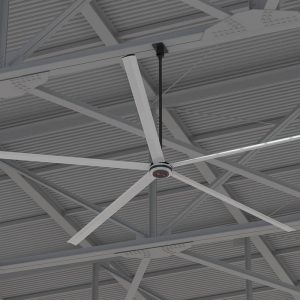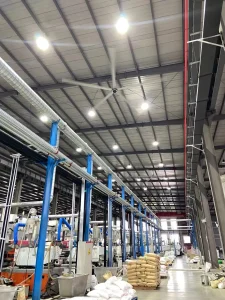Struggling with stifling heat in your large facility? High energy bills from constant air conditioning making you sweat even more? Traditional cooling methods often fall short or cost a fortune, leaving your workspace uncomfortable and potentially impacting productivity by up to 15% in hot conditions.
Industrial fans, particularly High-Volume Low-Speed (HVLS) fans, don’t lower the air temperature like air conditioning, but they do make a room feel significantly cooler. They achieve this through evaporative cooling – accelerating sweat evaporation from the skin – and by improving air circulation, which prevents stagnant hot air pockets and distributes conditioned air more effectively. This creates a much more comfortable and energy-efficient environment in large industrial spaces like warehouses and factories.

HVLS FANS
At its core, an industrial fan works by creating airflow. Unlike air conditioning systems that chemically cool the air temperature, fans use the principle of convection and evaporative cooling. When air moves across our skin, it speeds up the evaporation of moisture (sweat). This evaporation process requires energy, which it draws from our body heat, making us feel cooler – potentially feeling up to 8°F (4.4°C) cooler!
Fan Cooling vs. Air Conditioning:
| Feature | Industrial Fan (esp. HVLS) | Air Conditioning System |
| Mechanism | Air Movement (Evaporative Cooling) | Refrigeration Cycle (Heat Removal) |
| Air Temp | Does not lower air temperature | Lowers air temperature |
| Effect | Makes occupants feel cooler | Makes the air actually colder |
| Primary Use | Enhance comfort, circulate air, destratify | Precise temperature control |
Industrial fans, especially large industrial models like HVLS fans, are designed to move large amounts of air effectively across vast areas. They create consistent air movement, breaking up stagnant, hot air layers and ensuring that the air around people is constantly being refreshed. This continuous airflow maximizes the evaporative cooling effect, making the work environment feel several degrees cooler than the actual thermostat reading. As manufacturers of HVLS fans, we engineer our products precisely for this purpose – maximizing perceived cooling through efficient air circulation.
Furthermore, the ventilation provided by an industrial fan helps to exhaust trapped heat and pollutants, improving overall air quality. While they don’t introduce cool air in the way an AC unit does, the powerful air circulation ensures that any existing cooler air (perhaps from limited AC use or cooler night air) is distributed evenly throughout the large space, preventing hot spots and creating a more uniform and comfortable temperature profile.
The primary mechanism is evaporative cooling, as mentioned. Our bodies naturally sweat to regulate temperature. When that sweat evaporates, it takes heat with it. An industrial fan significantly accelerates this process by increasing the airflow over the skin. The faster the sweat evaporates, the faster heat is drawn away from the body, leading to a sensation of coolness. This effect can make occupants feel up to 8°F (4.4°C) cooler, a significant difference in comfort without touching the thermostat.
Other contributing factors include:
Destratification: Heat naturally rises. In high-ceilinged buildings (warehouses, factories), this creates layers of air, with the hottest air near the ceiling. Large industrial fans (especially HVLS fans) create large columns of air that gently mix these layers.
Summer: Disperses trapped ceiling heat.
Winter: Pushes trapped warm air down to the floor level (can reduce heating costs by 20-30%).
Stagnation Prevention: Continuous air movement prevents stagnant air, eliminating feelings of stuffiness and improving the perception of freshness.
“It’s not just about feeling cool; it’s about creating a more pleasant, breathable, and productive work environment, especially crucial in industrial settings where heat stress is a real concern.”
This consistent air movement ensures the air throughout the industrial space remains dynamic, contributing significantly to perceived comfort and well-being in demanding industrial environments.
Yes, for cooling large spaces, HVLS fans offer significant advantages over traditional high-speed industrial fans. They operate on fundamentally different principles, leading to distinct outcomes.
HVLS Fans vs. Traditional High-Speed Fans:
| Feature | HVLS Fans | Traditional High-Speed Fans |
| Size | Large Diameter (7-24 ft) | Smaller Diameter |
| Speed | Low RPM | High RPM |
| Airflow Pattern | Broad, deep column; gentle, pervasive breeze | Fast, turbulent jets; dissipates quickly |
| Coverage | Very large area (up to 20,000+ sq ft) | Smaller, localized area |
| Noise | Very quiet operation | Can be significantly noisy |
| Energy Efficiency | Extremely High (moves more CFM per watt) | Lower efficiency for large area coverage |
| Best Use | Whole-space air circulation, destratification | Spot cooling, directional airflow, ventilation |
High-Volume Low-Speed (HVLS) fans feature large fan blades and rotate slowly, allowing them to move more air – vast volumes – gently and steadily over a much wider area. This widespread, gentle air movement is far more effective for consistent evaporative cooling large spaces and achieving destratification without the annoying drafts and high noise levels associated with smaller fans.
As manufacturers deeply familiar with Everything You Need to Know About High-Volume Low-Speed Fans, we’ve seen the impact. A single HVLS industrial fan can often replace 6-10 smaller high-speed fans, providing better overall comfort while consuming up to 80% less energy. This is why they are better than regular fans for most large industrial applications focused on whole-space comfort and efficiency.
Whether industrial fans can replace air conditioning entirely depends on several factors:
Climate: Hot and humid vs. moderate and dry.
Building Insulation: Well-insulated spaces retain coolness better.
Internal Heat Load: Machinery, processes, lighting, and occupancy generate heat.
Required Temperature: Need for precise temperature control vs. general comfort improvement.
In many moderate climates or facilities without extreme heat loads, a well-designed system of HVLS fans can often provide sufficient comfort to eliminate or drastically reduce the need for expensive air conditioning systems. The perceived cooling effect keeps workers comfortable.
However, in very hot/humid conditions or high heat-load environments, industrial fans serve as powerful supplements to air conditioning.
The Hybrid Approach: Using HVLS fans with AC allows raising the thermostat by 5-8°F (3-4°C) while maintaining comfort. This leverages the fan’s efficiency for air circulation and the AC’s power for peak heat removal, often cutting cooling energy costs by 25-50%.
This combined strategy is frequently the most cost-effective and comfortable solution for large warehouse environments. Fans provide immediate comfort, distribute cool air effectively, and reduce AC runtime, while the AC handles the extreme temperature peaks. Considering fans vs solely relying on AC often leads to significant operational savings.

Can Industrial Fans Replace Air Conditioning in a Warehouse
The air circulation capacity varies greatly. Traditional high-speed fans create fast, localized jets. HVLS fans, however, are designed to move large amounts of air volume across vast areas.
Typical HVLS Fan Airflow: A single large industrial fan (e.g., 24 ft diameter) can move 250,000 to 350,000+ CFM (Cubic Feet per Minute).
Coverage Area: This allows one HVLS fan to effectively manage air circulation in spaces up to 20,000 – 25,000 square feet.
The way HVLS fans move air is key: slow rotation creates a deep, non-turbulent column of air that reaches the floor and spreads outwards 360 degrees. This ensures optimal air circulation and achieves several crucial goals:
Effective Cooling: Consistent airflow across occupants’ skin.
Destratification: Thorough mixing of air layers for temperature uniformity.
Enhanced Ventilation: Assists exhaust systems, improving the air exchange rate.
Better Air Quality: Prevents stagnant air, reducing stuffiness and pollutant concentration.
Moisture Control: Speeds up drying processes.
We design our M750 Series HVLS Fans specifically to maximize this effective CFM, ensuring comprehensive air circulation for even the largest industrial space without creating disruptive drafts.
Industrial fans cater to diverse needs. Understanding the main types of industrial fans helps select the right tool:
| Fan Type | Description | Primary Use | Key Characteristics |
| HVLS Ceiling Fans | Very large diameter (7-24 ft), slow speed ceiling fan. | Whole-space cooling, destratification, air circulation in large open areas. | High volume, low speed, energy-efficient, quiet. |
| Axial Fans (Panel/Wall) | Propeller-style blades move air parallel to axis, mounted in openings. | Ventilation (exhausting hot air / drawing in fresh air), localized cooling. | Moves high volume at low pressure. |
| Axial Fans (Tube/Vane) | Axial fan housed in a cylinder, sometimes with guide vanes. | Ducted ventilation systems, higher pressure applications than panel fans. | More pressure capability than panel fans. |
| Centrifugal Fans (Blowers) | Impeller draws air in axially, discharges perpendicularly (90 degrees). | Ducted systems, material handling, high-pressure needs, spot cooling. | High pressure, lower volume than axial/HVLS. |
| Portable/Drum Fans | Large, high-speed axial fans, often mobile. | Spot cooling, drying, temporary ventilation. | High speed, directional, can be noisy. |
While various fans include specialized uses, for overall cooling large spaces like warehouses or MANUFACTURING floors effectively and efficiently, HVLS fans are typically the superior choice due to their extensive coverage and low energy consumption.
Industrial fans and air conditioning offer different paths to thermal comfort. Here’s a direct comparison (fans vs AC):
| Feature | Industrial Fans (esp. HVLS) | Air Conditioning Systems |
| Energy Use | Very Low (e.g., 1-2 kW for large HVLS) | Very High (e.g., 50-100+ kW for same space) |
| Mechanism | Air Movement (Evaporative Cooling) | Refrigeration Cycle (Heat Removal) |
| Air Temperature | Unchanged | Lowered |
| Humidity | No direct change (can aid drying) | Reduced (Dehumidification) |
| Coverage | Excellent for large, open areas | Depends on ductwork design (potential hot/cold spots) |
| Air Quality Effect | Improves circulation, reduces stagnation | Filters air, can recirculate existing air |
| Upfront Cost | Moderate | High |
| Operating Cost | Very Low | High |
| Environmental Impact | Low | High (due to energy use & refrigerants) |
The Bottom Line: HVLS fans provide perceived cooling very efficiently, ideal for general comfort and air circulation. Air conditioning provides actual cooling and dehumidification but at a much higher energy and financial cost. For many industrial environments, using fans to ensure constant air movement supplemented by AC is the most balanced and economical approach, saving 3-5% on cooling costs for every degree (°F) the thermostat is raised.
Absolutely. Beyond cooling, industrial fans significantly contribute to better air quality in industrial settings. Stagnant air is a breeding ground for problems.
How Industrial Fans Boost Air Quality:
Combat Stagnancy: Continuous air movement from fans like the M650 Series HVLS Fans prevents air from becoming still, ensuring constant mixing. Fact: Studies show moving air can reduce the concentration of airborne particulates.
Enhance Ventilation: By circulating air throughout, fans help move stale or contaminated air towards exhausts, boosting the effectiveness of ventilation systems and increasing the air exchange rate.
Control Moisture & Humidity: Airflow accelerates evaporation, reducing surface moisture and inhibiting mold/mildew growth, which often cause poor indoor air quality. Data Point: Can reduce drying times for spills or processes significantly.
Disperse Pollutants: In manufacturing or AUTOMOTIVE settings, fans help dilute and disperse fumes, dust, or vapors, preventing localized high concentrations near workers. They push air away from sources.
Temperature Uniformity: Destratification ensures ventilation systems work on a more consistent air mass, improving overall efficiency.
Using industrial fans are also a proactive measure against poor indoor air quality. HVLS fans, with their large-scale gentle air movement, are particularly adept at delivering these benefits facility-wide.

Can Industrial Fans Improve Air Quality in Industrial Settings
Selecting the right industrial fan requires careful consideration. Use this checklist:
| Consideration | Key Questions | Why It Matters |
| Space Characteristics | What are the dimensions (LxWxH)? Square footage? Ceiling height? | Determines required fan size (diameter), number of fans, and type (HVLS vs other). |
| Primary Goal | Cooling comfort? Destratification (heating savings)? Ventilation aid? Moisture control? | Guides selection towards fans optimized for that purpose (e.g., HVLS for broad goals). |
| Obstructions | Are there beams, lights, sprinklers, cranes? What are the clearances? | Ensures safe installation and unimpeded airflow. HVLS fans need clear space. |
| Control Needs | Simple on/off? Variable speed? Networked (BMS integration)? Automated operation (temp/humidity sensors)? | Matches operational complexity and potential for automation/efficiency. |
| Noise Tolerance | Is the area occupied frequently? Is low noise critical? | HVLS fans are significantly quieter than high-speed fans. |
| Energy Efficiency | What is the CFM/Watt rating? What are the projected long-term energy costs? | Impacts operational expenses and ROI. HVLS fans excel here. |
| Budget | What is the upfront budget? What is the expected payback period based on energy savings? | Balances initial investment with long-term value. |
| Installation/Maint. | What are the installation requirements? What is the recommended maintenance schedule? | Factor in ease of setup and long-term upkeep. Check manufacturer support. |
Pro Tip: Don’t underestimate ceiling height! It’s crucial for HVLS fan selection. Consulting with specialists, like our team at Vindus Fans, using resources like “How to Choose a HVLS Fan” can prevent costly mistakes and ensure you get the optimal industrial ceiling fan solution.
Yes, substantial energy savings are a major advantage, especially with HVLS fans.
Sources of Energy Savings:
Reduced AC Load (Cooling Savings):
Perceived cooling allows raising AC thermostat 5-8°F (3-4°C).
Each 1°F rise saves ~3-5% on cooling energy costs.
Potential AC runtime reduction: 25-50% or more in hybrid systems.
Destratification (Heating Savings):
Pushing trapped ceiling heat down reduces heating system workload.
Typical heating energy costs savings: 20-30%, sometimes higher.
Mini Case Example: A 100,000 sq ft warehouse in a cold climate reported a 28% reduction in natural gas usage for heating after installing HVLS fans for winter destratification.
Higher Fan Efficiency:
HVLS fans move more air (CFM) per watt than multiple smaller fans.
Direct electricity savings for achieving the same level of air circulation.
Targeted Comfort:
Fans provide comfort where needed, reducing the need to condition unoccupied areas.
These combined effects make HVLS industrial fans a powerful tool for reducing operational expenses and enhancing sustainability in industrial applications. The ROI is often achieved within 1-3 years based purely on energy savings.
How much cooler can an industrial fan make a room feel?
An industrial fan, particularly an HVLS fan, doesn’t lower the actual air temperature but can make occupants feel 5-8°F (3-4°C) cooler through the wind chill effect (evaporative cooling). This perceived cooling significantly enhances comfort in hot air environments.
Do warehouse fans use a lot of electricity?
Compared to air conditioning systems, warehouse fans, especially HVLS fans, use very little electricity. A large HVLS fan might consume only 1-2 kW, while cooling the same large space with AC could require 50-100 kW or more. This makes industrial fans a highly energy-efficient solution for improving comfort and air circulation.
What is the difference between an industrial ceiling fan and a regular ceiling fan?
Industrial ceiling fans, especially HVLS fans, are much larger (7-24 ft vs. 3-5 ft), built more robustly for continuous duty in harsh industrial environments, and designed to move large amounts of air efficiently over vast areas. Regular ceiling fans are intended for smaller residential or commercial spaces and move significantly less air volume, making them ineffective for cooling large spaces like warehouses. An industrial fan offers superior airflow and durability.
Can you use industrial fans in winter?
Yes! Industrial fans, specifically HVLS fans, are very beneficial in winter. By running them in reverse or at a slow forward speed, they gently push the warm air that collects near the ceiling back down to the floor level without creating uncomfortable drafts. This process, called destratification, helps to equalize temperatures, improve comfort, and significantly reduce heating energy costs (often by 20-30%).
Are industrial fans noisy?
Noise levels vary by type. Traditional high-speed fans can be quite noisy due to the fast-moving air. However, HVLS fans, despite their size, operate at low speeds and are surprisingly quiet (often in the 40-55 dBA range, comparable to a quiet office). The gentle air movement produces minimal noise, making them suitable for most industrial settings.
How do I know which industrial fan is right for my facility?
Choosing the right industrial fan depends on your space size, ceiling height, primary goals (cooling, heating, ventilation), budget, and existing systems. Consider factors like airflow needs (CFM), coverage area, energy efficiency, noise level, and control options. Consulting with an HVLS fan specialist or manufacturer like Vindus Fans can help you assess your needs and determine the optimal fan for your needs, whether it’s for a warehouse, factory, or SPORTS CENTERS.
Perceived Cooling Power: Industrial fans (esp. HVLS) make spaces feel 5-8°F cooler via evaporative cooling, without changing air temperature.
Circulation Champions: They excel at moving vast volumes of air, eliminating stagnant air, aiding ventilation, and distributing conditioned air.
Major Energy Savers: HVLS fans use minimal electricity compared to air conditioning, drastically cutting cooling energy costs.
Year-Round Value: Provide summer cooling comfort and winter heating savings (destratification can save 20-30%+).
Air Quality Allies: Improve air quality by reducing stagnation, dispersing pollutants, and controlling moisture.
HVLS is King for Large Spaces: For warehouses, factories, etc., HVLS fans offer superior coverage, efficiency, and quietness over traditional fans.
Smart Synergy with AC: Often best used with air conditioning systems to enhance comfort, improve distribution, and allow higher, energy-saving thermostat settings.
Ready to transform the comfort and efficiency of your large facility? As dedicated manufacturers of high-performance air movement solutions, we understand the unique demands of industrial spaces. Discover how our M650 Series HVLS Fans can benefit you, or learn more about our Company Introduction. Let Vindus Fans engineer a cooler, more productive, and cost-effective environment for you. Contact us for a personalized consultation today!

Hi, I’m Michael Danielsson, CEO of Vindus Fans, with over 15 years of experience in the engineering and design industry. I’m here to share what I’ve learned. If you have any questions, feel free to contact me at any time. Let’s grow together!